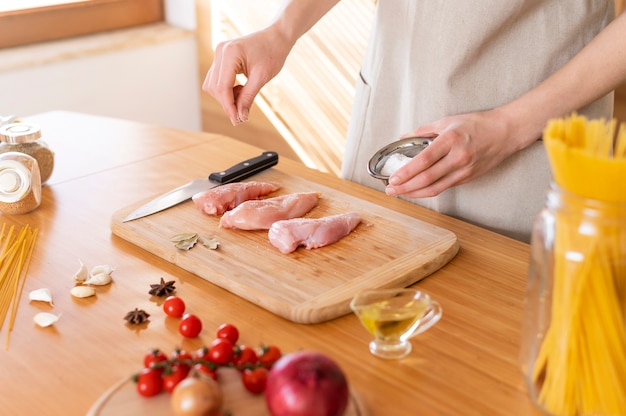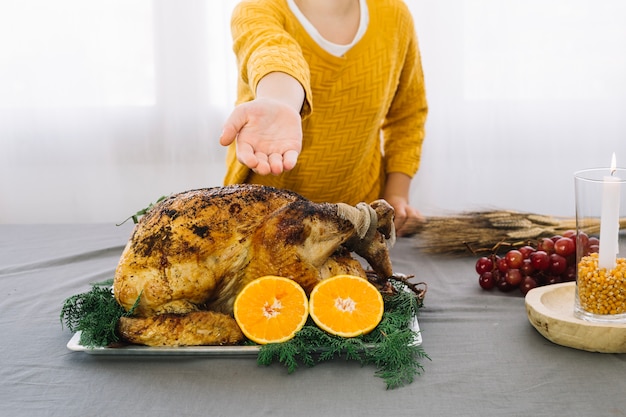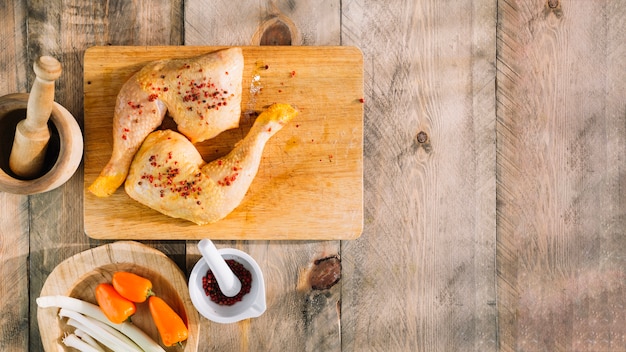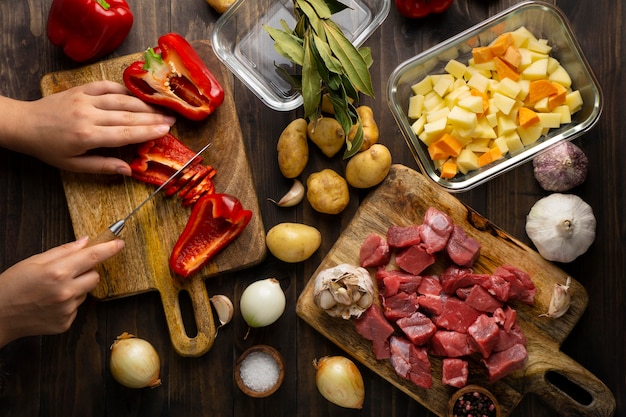Let's talk turkey! Not about the stressful family gatherings, although those can certainly be a bit of a turkey-fest, but about the bird itself. Specifically, the humble turkey breast with bone.
I've been cooking turkeys for years, and I've learned a thing or two about getting that perfect, juicy, succulent bird. But it's the bone-in breast that really gets me going. It's a bit trickier than a boneless one, sure, but the flavour? Oh, the flavour! It's simply unbeatable.
So, whether you're a seasoned chef or a complete newbie in the kitchen, this guide is for you. We'll cover everything from choosing the right turkey to figuring out the perfect cooking time. We'll even delve into some handy tips and tricks to make sure your turkey breast is the star of the show.
Get ready to impress your guests (or just yourself) with a show-stopping roast turkey breast, every time!
(Part 1) Choosing the Right Turkey

Size Matters: Finding the Perfect Fit
First things first, you need to choose the right turkey. Don't just grab the biggest one you can find – it's all about finding the right size for your needs. Think about how many people you're feeding and how much you want leftover (because let's be honest, leftover turkey sandwiches are the best!).
As a general rule of thumb, aim for about 1 pound of turkey per person. If you're feeding a crowd of 10, a 10-12 pound turkey breast would be a good choice.
Looking for the Perfect Bird: The Supermarket Safari
When you're in the supermarket, take a good look at those turkeys. You want one that feels firm and plump, not too skinny or floppy. Give it a gentle squeeze – it should feel springy, not squishy. Check the skin, it should be smooth and have a healthy colour, no weird discolouration or bruising.
Avoid turkeys with any signs of freezer burn or overly dry patches.
Bone-in vs. Boneless: The Great Debate
Now, here's where things get interesting. bone-in turkey breast offers a richer flavour and juicier meat. The bone acts as a conductor of heat, helping to keep the breast moist while it cooks. It also adds a beautiful depth of flavour that you won't get with boneless. However, it does take longer to cook, and you need to be extra careful to ensure it's cooked through.
Boneless turkey breast, on the other hand, is quicker and easier to cook. It's also a great option if you're short on time. But it can sometimes dry out if you're not careful.
Personally, I'm a bone-in kinda gal. I love that deep, savory flavour that only comes from cooking the turkey with the bone. Plus, it adds a bit of extra drama to the whole roasting process.
(Part 2) Getting Ready to Roast: Prepping for Perfection

Prepping the Bird: A Clean Slate
Alright, you've got your turkey. Now it’s time to get it ready for the oven. First things first, give it a good rinse under cold water and pat it dry with paper towels. This removes any excess moisture and helps the skin crisp up nicely.
Brine or Not to Brine: The Salt Debate
Now, you might have heard about brining. Basically, it's soaking the turkey in a salty solution to make it extra juicy and flavorful. It’s a bit of a controversial topic – some swear by it, others think it’s unnecessary.
I personally like to brine my turkeys, especially if they're on the lean side. It adds a ton of moisture and flavour, and makes the meat super tender. If you decide to brine, there are tons of recipes online. Just make sure to allow enough time, as brining typically takes at least 4-6 hours.
Seasoning with Love: The Spice of Life
Now, for the fun part: seasoning! This is where you get to experiment and add your own personal touch. I like to keep it simple with a blend of salt, pepper, paprika, and garlic powder. But feel free to get creative and add your favourite herbs and spices.
Don't be afraid to be bold! A little bit of cayenne pepper can give your turkey a nice kick. You can also add a splash of citrus zest or some fresh herbs for a more aromatic flavour.
Stuffing or No Stuffing: A Classic Debate
This is another debate that rages on every Thanksgiving. Stuffing inside the turkey or outside? It's a matter of personal preference, but I prefer to stuff the turkey separately. It helps the bird cook more evenly and prevents the stuffing from getting soggy. Plus, you can cook the stuffing in a separate pan, which means less chance of overcooking the turkey while the stuffing is finishing up.
(Part 3) Cooking Time: The Big Question

Oven Temperature: Finding the Sweet Spot
For a turkey breast with bone, you want to cook it at a moderate temperature, around 325°F (160°C). This ensures even cooking and prevents the meat from drying out.
The Rule of Thumb: A Starting Point
A general rule of thumb is to cook a bone-in turkey breast for about 20-25 minutes per pound, or until the internal temperature reaches 165°F (74°C). However, this is just a starting point. You need to consider the size and thickness of your turkey breast.
For example, a 6-pound turkey breast might take about 1 hour and 40 minutes to cook, while a 10-pound breast could take up to 2 hours and 30 minutes.
Using a meat thermometer: The Key to Success
The only way to be absolutely sure your turkey is cooked through is to use a meat thermometer. Insert it into the thickest part of the breast, making sure not to touch the bone. If the thermometer reads 165°F (74°C), your turkey is ready to be devoured!
(Part 4) The Art of Roasting: From Oven to Table
Getting it Right in the Oven: Roasting Perfection
Now, you're ready to roast your turkey! Preheat your oven to the desired temperature and place the turkey breast in a roasting pan. Make sure it’s placed in the centre of the oven, where the heat is most consistent.
Basting: The Moisture Magic
During cooking, it’s important to keep an eye on the turkey and baste it with pan juices or butter every 30-45 minutes. Basting helps keep the meat moist and adds a delicious flavour.
You can also add a few tablespoons of water to the bottom of the roasting pan to create steam, which will help keep the turkey moist.
Resting Time: A Crucial Step
Once your turkey breast has reached the desired internal temperature, it's important to let it rest for at least 15 minutes before carving. This allows the juices to redistribute and prevents the meat from becoming dry.
You can cover the turkey loosely with foil to keep it warm while it rests.
(Part 5) Carving Like a Pro: Slicing with Precision
The Right Tools for the Job: Carving Equipment
You'll need a sharp carving knife, a carving fork, and a cutting board. A good carving knife will make the slicing process much easier and will give you nice, clean slices. Use a carving fork to hold the turkey breast steady while you slice it.
Getting Those Beautiful Slices: Slicing Technique
Start by carving along the bone, then slice the breast into thin, even pieces. It's best to cut against the grain, which helps to make the meat tender.
(Part 6) Tips and Tricks for Turkey Breast Success
Keeping it Juicy: Moisture Is Key
Don't overcook it: The biggest mistake people make is overcooking their turkey. It can lead to dry, tough meat. Use a meat thermometer to ensure it's cooked through but not overcooked.
Basting is key: Basting helps keep the turkey moist and flavorful. Use pan juices or butter for the best results.
Rest it, rest it, rest it: Don't rush to carve your turkey right out of the oven. Let it rest for at least 15 minutes to allow the juices to redistribute.
Flavour Boosters: Adding Depth and Complexity
Stuffing: A classic combination with turkey, but don’t forget to cook the stuffing separately to avoid soggy mess.
Herbs and spices: Experiment with different herbs and spices to add flavour to your turkey. I like to use a blend of thyme, rosemary, sage, and garlic powder.
Citrus: Adding a slice of lemon or orange to the roasting pan can add a bright, tangy flavour to the turkey.
Leftover Love: Delicious Ways to Use Leftovers
Sandwiches: Leftover turkey is perfect for sandwiches. Add some cranberry sauce, stuffing, and mayonnaise for a delicious lunch.
Soup: Make a hearty turkey soup with leftover turkey, broth, vegetables, and noodles.
Salads: Slice leftover turkey and add it to your favorite salad.
(Part 7) Turkey Breast with Bone Cooking Time Chart
Here's a handy table to give you a better idea of how long to cook your turkey breast based on its weight:
| Turkey Breast Weight (lbs) | Cooking Time (minutes) |
|---|---|
| 4-5 lbs | 1 hour 40 minutes - 2 hours |
| 6-7 lbs | 2 hours - 2 hours 20 minutes |
| 8-9 lbs | 2 hours 20 minutes - 2 hours 40 minutes |
Remember, these are just estimates, and cooking time can vary depending on your oven and the thickness of the breast. It's always best to check the internal temperature with a meat thermometer.
(Part 8) FAQs: Answering Your Turkey Questions
1. Can I cook a turkey breast with bone in a slow cooker?
Yes, you can! It’s a great option for a hands-off cooking method. Just make sure to use a slow cooker that's large enough for your turkey breast. You can use a slow cooker liner to make cleanup a breeze. Cook it on low for 6-8 hours or on high for 3-4 hours.
2. What are some good side dishes to serve with turkey breast?
There are endless possibilities! Some classics include mashed potatoes, gravy, cranberry sauce, stuffing, roasted vegetables, and green bean casserole. For a more festive feel, you can also add Brussels sprouts, sweet potatoes, or butternut squash.
3. How do I know if my turkey breast is cooked through?
The best way to tell if your turkey breast is cooked through is to use a meat thermometer. Insert it into the thickest part of the breast, making sure not to touch the bone. The internal temperature should reach 165°F (74°C).
4. Can I freeze a turkey breast with bone?
Yes, you can freeze a turkey breast with bone. Just make sure it's wrapped tightly in plastic wrap or freezer paper. It can be frozen for up to 2 months. Thaw it in the refrigerator for 2-3 days before cooking.
5. What should I do if my turkey breast is overcooked?
Unfortunately, overcooked turkey can be dry and tough. While there's no magic trick to bring it back to life, there are ways to salvage it. You can add a little moisture by basting it with pan juices or adding a bit of broth. You can also make it into a delicious sandwich or soup.
(Part 9) The Joy of a perfect turkey Breast: A Culinary Triumph
There you have it! You've got all the tools you need to cook a truly spectacular turkey breast. I know it can be a bit daunting, especially if you’re a beginner, but trust me, it’s totally worth the effort.
The joy of carving a perfectly roasted turkey breast, the aromas that fill your kitchen, and the satisfied smiles of your guests – it’s all part of the magic. So, grab your ingredients, put on your apron, and get ready to create something truly special. Happy cooking!
Everyone is watching

Perfect Rice Every Time: The Ultimate Guide to Cooking Rice
Cooking TipsAs a self-proclaimed foodie, I've always been a bit obsessed with rice. It's the foundation of countless cuisi...

Ultimate Guide to Cooking the Perfect Thanksgiving Turkey
Cooking TipsThanksgiving. Just the word conjures up images of overflowing tables laden with delicious food, the scent of r...

The Ultimate Guide to Cooking Asparagus: Tips, Techniques, and Recipes
Cooking TipsAsparagus. The mere mention of this spring delicacy conjures up images of vibrant green spears, crisp and burs...

Can You Cook Spaghetti with Gasoline? (The Shocking Truth)
Cooking TipsWe've all seen those crazy internet trends. You know, the ones that make you wonder, "Did someone actually try...

Chorizo and Eggs Recipe: The Ultimate Guide
Cooking TipsRight, let’s talk about chorizo and eggs. You know, that classic Spanish dish that's always a winner. It's th...
